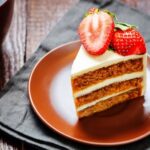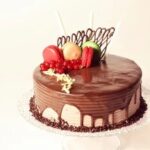Are you looking for creative ways to decorate a cake without using traditional frosting? Whether you’re avoiding frosting due to dietary restrictions, personal preference, or simply wanting to try something new, there are plenty of alternative decorating techniques to explore. From fresh flowers and fruit to chocolate ganache and edible glitter, the possibilities are endless when it comes to creating a beautiful and delicious cake without relying on frosting.
When it comes to decorating a cake without frosting, the options are truly limitless. Using ingredients like whipped cream, cream cheese, nuts, seeds, and fondant can add texture, flavor, and visual interest to your dessert creation. And if you’re looking for more natural options, there are plenty of ways to incorporate color and flair using food coloring from fruits and vegetables.
In this article, we will delve into different techniques for decorating cakes without frosting and provide tips for selecting the right base cake that can stand on its own. Whether you’re aiming for a light and airy look or a polished finish without the heaviness of traditional frosting, we’ve got you covered with creative ideas for showcasing your cake in style. Let’s explore the exciting world of cake decoration beyond traditional frosting.
Different Decorating Techniques
Decorating a cake without frosting opens up a world of creative possibilities for adding visual appeal and flavor to your baked masterpiece. Fresh flowers can create a stunning, natural look and add an elegant touch to any cake.
Edible flowers such as roses, pansies, or lavender can be carefully placed on top of the cake or around the edges for a beautiful and fragrant decoration. It’s important to ensure that the flowers are pesticide-free before using them as a cake garnish.
Another alternative decorating method is using fruit to add both color and flavor to your cake. Slices of strawberries, kiwi, or mandarin oranges can be arranged in decorative patterns on top of the cake. Additionally, you can use berries or citrus zest to infuse the batter itself with bursts of vibrant color and juicy flavor.
For a rich and decadent option, consider using chocolate ganache as a frosting alternative. The glossy, smooth texture of ganache not only adds an indulgent touch to your cake but also provides a blank canvas for embellishments like fresh fruit or edible gold dust. To create an eye-catching design with powdered sugar or edible glitter, use stencils to create intricate patterns on top of the cake without needing traditional frosting.
These creative options for decorating cakes without frosting allow you to customize the look and taste of your dessert while avoiding the heaviness or excessive sweetness that comes with traditional frosting. Whether you prefer an elegant floral display, a burst of fruity freshness, or the luxurious richness of chocolate ganache, there are countless ways to adorn your cake without relying on frosting alone.
Choosing the Right Base
When it comes to decorating a cake without frosting, choosing the right base is crucial to ensure that the cake can stand on its own and still be visually appealing. Certain types of cakes lend themselves well to being enjoyed without traditional frosting, and options such as rich chocolate cake, moist carrot cake, or fluffy vanilla sponge are excellent choices.
Rich Chocolate Cake
A rich chocolate cake is an ideal option for decorating without frosting due to its decadent flavor. The rich cocoa in the cake itself provides a flavorful base that does not necessarily require additional frosting. Instead, you can enhance the look and taste of a chocolate cake with fresh berries, a sprinkle of powdered sugar, or even a drizzle of chocolate ganache for added decadence.
Moist Carrot Cake
Carrot cake’s naturally moist texture and subtle sweetness make it a great candidate for decorating sans frosting. The addition of shredded carrots, raisins, and warm spices like cinnamon and nutmeg offer visual interest and depth of flavor to the cake. For an alternative to traditional cream cheese frosting, consider topping a carrot cake with whipped cream stabilized with a touch of gelatin for added stability.
Fluffy Vanilla Sponge
A fluffy vanilla sponge is another excellent choice for showcasing a decorated cake without traditional frosting. The lightness and delicate crumb of this type of cake allow other decoration elements to shine. Consider using fresh fruits like sliced strawberries or kiwi on top of the vanilla sponge layers, complemented by a dusting of powdered sugar for an elegant presentation.
Whipped Cream or Cream Cheese
Whipped cream and cream cheese are excellent alternatives to traditional frosting when it comes to decorating a cake. The light and airy texture of whipped cream or the creamy tang of cream cheese can add a delightful touch to any cake while keeping it free from heavy, sugary frosting. Whipped cream is perfect for those who appreciate a lighter, fluffier finish, while cream cheese provides a slightly tangy flavor that complements a wide range of cake flavors.
To use whipped cream or cream cheese as a frosting alternative, it’s essential to ensure that your cake is suitable for these toppings. Consider the flavor profile of your cake – a vanilla sponge or light chiffon cake pairs beautifully with whipped cream, while a rich chocolate or red velvet cake may benefit more from the tangy contrast of cream cheese.
Additionally, make sure your cake has fully cooled before spreading whipped cream or cream cheese on top to prevent melting or collapsing.
When using whipped cream as an alternative to frosting, consider stabilizing it with gelatin or powdered sugar to help it hold its shape better. As for using cream cheese, remember that it should be softened at room temperature before being mixed with any additional flavorings like vanilla extract or citrus zest. Both options can be piped onto the cake using pastry bags fitted with decorative tips for an elegant finish.
| Alternative | Cake Pairing |
|---|---|
| Whipped Cream | Vanilla Sponge Cake |
| Cream Cheese | Rich Chocolate Cake |
Incorporating Nuts and Seeds
Decorating a cake without using traditional frosting opens up a world of creative possibilities, and one way to add texture and visual interest is by incorporating nuts and seeds. Chopped nuts such as pecans, walnuts, or pistachios can be pressed onto the sides of the cake to create a rustic, earthy look.
Alternatively, sliced almonds can be delicately arranged in concentric circles on top of the cake to provide visual appeal. Edible seeds like poppy seeds or sesame seeds can also be sprinkled on top of the cake to add an unexpected crunch and burst of flavor.
Aside from adding aesthetic appeal, nuts and seeds also contribute depth of flavor to a cake. For example, toasted coconut flakes can offer a nutty sweetness, while black sesame seeds provide a subtle smokiness. When choosing which nuts and seeds to use for decorating a cake without frosting, it’s important to consider not only their appearance but also how their flavors will complement the overall taste of the cake.
In addition to enhancing the overall look and taste of a cake, incorporating nuts and seeds can also cater to those with dietary restrictions. By using alternative decorative elements that are gluten-free or vegan-friendly (such as chopped macadamia nuts or chia seeds), bakers can create beautiful cakes that are accessible to individuals with various dietary considerations.
| Decorative Element | Effect |
|---|---|
| Chopped Nuts | Create rustic, earthy look; adds depth of flavor |
| Sliced Almonds | Delicate visual appeal; offers nutty sweetness |
| Edible Seeds | Unexpected crunch; provides burst of flavor |
Using Fondant
When it comes to decorating a cake without frosting, one creative and versatile option is using fondant. Fondant is a pliable icing that can be rolled out and draped over cakes to create a smooth, polished finish. It can also be molded into various shapes and figures to add decorative elements to the cake. Here are some ways to use fondant to achieve a beautifully decorated cake without traditional frosting:
- Smooth Finish: One of the biggest advantages of using fondant is that it allows you to achieve a flawless, smooth finish on your cake. This is especially useful when you want your cake to have a clean and polished look without the heaviness of buttercream or ganache.
- Decorative Elements: Fondant can be used to create intricate designs, patterns, and even 3D decorations for your cake. Whether you want to make delicate flowers, geometric shapes, or figurines for a themed cake, fondant offers endless possibilities for creativity.
- Color Options: Fondant comes in a variety of colors, or it can be tinted with food coloring to achieve custom shades. This makes it easy to coordinate the color scheme of your cake with the overall theme or event.
Overall, fondant provides a lightweight and versatile alternative for decorating cakes without traditional frosting. Its smooth finish and ability to hold intricate designs make it an excellent choice for creating visually stunning cakes for any occasion.
It’s important to note that while fondant adds aesthetic appeal to your cake, some people may choose not to eat it due to its texture or sweetness. Therefore, when using fondant as the primary decoration for your cake, it’s essential to inform your guests about its presence and provide alternative options for those who may prefer not to consume it.
Natural Food Coloring
When it comes to decorating a cake without traditional frosting, using natural food coloring options can be a great way to add vibrant colors without relying on artificial ingredients. Whether you’re looking for a healthier alternative or simply want to experiment with new decorating techniques, natural food coloring can offer a unique and playful touch to your cake. Here are some tips for using natural food coloring options such as beet juice, turmeric, or matcha powder:
- Using beet juice: Beet juice is a popular natural food coloring option that can add a beautiful pink or red hue to your cake. To use beet juice as a natural food coloring, simply extract the juice from fresh beets and mix it into your batter or icing. Keep in mind that the color may intensify as the cake bakes, so start with a small amount and adjust to your desired shade.
- Using turmeric: Turmeric is known for its vibrant golden-yellow color, making it an excellent choice for adding warmth and brightness to your cake. To use turmeric as a natural food coloring, mix the powder with a small amount of water to create a paste before incorporating it into your batter or icing. Be cautious when using turmeric, as too much can result in an overpowering flavor in your cake.
- Using matcha powder: Matcha powder offers a lovely green hue and adds a subtle earthy flavor to your cake. To use matcha powder as a natural food coloring, sift the powder before mixing it into your batter or icing to ensure that there are no clumps. Consider experimenting with different amounts to achieve the perfect shade of green for your cake.
Embracing natural food coloring options not only allows you to create visually stunning cakes but also provides an opportunity to highlight the beauty of naturally derived colors in baking. Whether you choose beet juice, turmeric, matcha powder, or other natural alternatives, incorporating these colorful ingredients can elevate the visual appeal of your cake without relying on artificial frosting.
Presentation and Display
In conclusion, decorating a cake without frosting offers a unique and creative approach to making delicious and visually appealing desserts. By exploring alternative methods such as using fresh flowers, fruit, chocolate ganache, powdered sugar, or edible glitter, individuals can add a personal touch to their cakes while avoiding the heaviness of traditional frosting.
Additionally, choosing the right base is crucial when decorating a cake without frosting – opting for a rich chocolate cake, moist carrot cake, or fluffy vanilla sponge can provide a solid foundation for showcasing decorative elements.
Furthermore, the use of whipped cream or cream cheese as a light and airy alternative to traditional frosting allows for versatility in decorating techniques. Incorporating nuts and seeds can add texture and visual interest to a cake without frosting, while the use of fondant can create a smooth and polished look.
Natural food coloring options such as beet juice, turmeric, or matcha powder can also be utilized to add color without relying on artificial frosting. Lastly, presentation and display play an essential role in showcasing a cake without frosting – utilizing cake stands, fresh garnishes, or decorative cake toppers can elevate the overall appearance of the dessert.
In essence, decorating a cake without frosting provides individuals with endless possibilities for creating visually stunning and delicious desserts. Whether it’s through the use of alternative decorating techniques, selecting the right base, incorporating different ingredients for visual appeal, or mastering the art of presentation and display – there are numerous ways to make an impact with unfrosted cakes.
By embracing these creative approaches and experimenting with different elements, individuals can elevate their baking skills while offering delightful treats that are as visually captivating as they are delicious.
Frequently Asked Questions
How Can I Decorate a Cake at Home Without Icing?
Decorating a cake at home without icing can be done using various alternative methods. One option is to use whipped cream, which can be sweetened and flavored to add a decorative touch to the cake.
Fresh fruit, such as sliced strawberries or kiwi, can also be used to create a colorful and natural topping for the cake. Another idea is to dust the cake with powdered sugar or cocoa powder through a stencil to create intricate designs on the surface.
What Can You Use Instead of Frosting on a Cake?
Instead of frosting, there are several alternatives that can be used to top a cake. For those who prefer a lighter option, whipped cream or coconut cream can be used as a substitute for traditional frosting.
A drizzle of chocolate ganache or caramel sauce can add a decadent touch to the cake without the need for spreading frosting. Additionally, fruit preserves or compotes can be spread on top of the cake for both flavor and visual appeal.
How Do You Practice Cake Decorating Without Frosting?
Practicing cake decorating without frosting involves exploring different techniques and tools that can enhance the appearance of the cake. Using fresh flowers, edible glitter, or even small candies can add dimension and interest to the cake’s decoration without relying on traditional frosting.
Experimenting with piping designs using melted chocolate or caramel can also provide an alternative way to practice decorating cakes without using frosting. Additionally, exploring different stenciling methods and patterns with powdered sugar or cocoa powder can help refine decorating skills without relying on frosting.

Welcome to my blog about home and family. This blog is a place where I will share my thoughts, ideas, and experiences related to these important topics. I am a stay-at-home mom with two young children. I hope you enjoy reading it! and may find some helpful tips and ideas that will make your home and family life even better!





